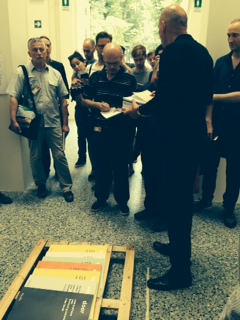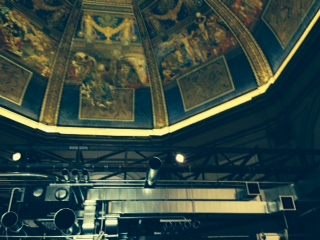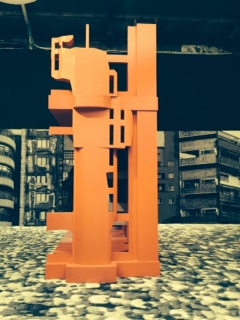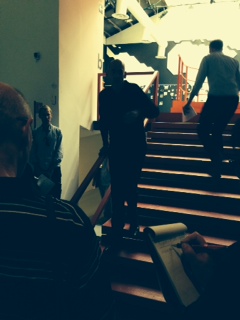I am staying in a Venetian hotel once the home of Alma Mahler, the woman who sent many talented hearts reeling and walking along the narrow often slightly off-fragrant Venetian streets that writer Mary McCarthy prowled when her love life was also a shambles so an invitation to write about Venice seemed the only logical thing to do.
Venice is certainly a city for lovers but it is also a city for seekers of solace even though the woman sitting next to me on the plane told me she would never come to Venice for anything other than a romantic tryst. Yet despite the map or app toting tourists on every footbridge I understand Mahler and McCarthy's quest since emotions run high here even if the acqua alta is in check.
My personal weapon against gloom is the Architecture Biennale of 2014 headed this year -- a six month long duration as opposed to the usual three -- by Dutch architect Rem Koolhaas who posits that its theme "Fundamentals" is not about architects but about architecture. An initial exposure to the brilliant rumpled but chic Italian architects at MoMA's famous design show of the seventies made them seem the perfect combination of artist and businessman to a SWF seeking SWM. So this return to the basics feels totally refreshing after the long years of starchitecture (not finished quite yet). Two morning pit stops at the 16th century Scuola di San Rocca -- which posits the more majesty one can carve into a building the more important and enduring it can be -- and the Accademia -- a structure filled with magnificent art whose walls and ceilings are in grave disrepair make arriving at the main pavilion of the Giardinale where Rem's unique take on the role of building in culture uplifts in a way that these monuments do not. I'm struck by the idea that deconstructing buildings down to their very essence to see what makes them tick has a majesty all its own.

Rem has taken the concept of concentrating on the elements that make up a building and the built environment and threaded them with personal narrative. In each case -- a window, a door, a set of stairs, a balcony, a ceiling, a facade, heating, roofing, ramps, elevators and escalators, toilets, walls, floors are on display in original and engaging ways -- their history, their future integrated with the stories of a few men (alas not women) who did not know their own needs would push the boundaries of what a fundamental could be. Wheelchair bound veterans who needed better access and dukes who were afraid of invasion personalize the development of things we now take very much for granted.

All of a sudden then, we are able to look at the very things that surround us with new eyes. How did it happen that we ended up with corridors -- once noble and stately interior allees -- that are now narrow pathways to get us out of places. What is it about a balcony that infuses Kings and Celebrities with pomp and occasionally dubious circumstance (Michael Jackson if you recall dangled baby Prince Michael II over the edge much to the chagrin of the worldwide baby police.)
"We don't know where architecture is going" says Koolhaas who himself has been rumored to have left building behind to concentrate on these kinds of philosophical quests. "Architects don't have any authority anymore" (Though he is clearly an exception to this rule.) Though he has collaborated with Harvard and MIT on many of the projects, and was eager to be inclusive, giving his collaborators full voice and credit on the press walk, this biennale exhibition seems infused with the singular vision of an architect who was once a journalist, has always used the written and spoken word as much of an element of his architecture as anything else. A book on each subject has been written and Wolfgang Tillmans enlisted to make a film; on the whole, the entire enterprise seems both pedagogic and sly. This is a fun house of mirrors and magic made entirely by the everyday.

Who ever thought a simple corridor once the magisterial egress of barons and lords could evoke all the claustrophobia of a horror film and why a hung ceiling can depress worker mood where a dome can literally lift ones spirits to the heavens. We see floors that respond to weight with sensors that record our energy and can convert it to something positive, like water over a dam. We see ornate Chinese temples reduced, somehow entirely logically, to their essence in blue foam core. We feel the experience of personal thermal bubbles that will encircle us in a harness of heat and allow us to be heated and cooled according to sensors that work with our circulation systems, energy efficient instead of heating whole rooms. (Google has just bought Nest, which is working on this technology controlled by a smart phone.) Gates, once portals to kingdoms are now layers of security that keep us from our goals. Toilets here are real "thrones," the management of daily waste lifted to an art form. We see Japanese models that automatically sense when a man will use and lift the seat cover, auto infuse with scent once flushed, and self clean, and early painted porcelain pissoirs where any duke or king would have happily laid down his royal scent. All to the audio track of continuously flushing water. You can see why Marcel Duchamp made a toilet the example of his Ready Made.

Of course the digital revolution is upon architecture and its elements just like every other discipline and the idea of my waste product or my hot flashes being controlled by some Orwellian sensor system feels, well, somehow, almost pornographic. I'm not sure I like my privacy invaded by body sensors any more than my credit card bouncing all over the Web.
Architecture, according to Rem, "stands with one foot in the present and one foot in the past." Here, he says as he demonstrates by spreading his legs in a kind of imitation of how people stand when they are in Greenwich, England standing over the line between two time zones. His bright blue socks and alligator shoes, thin navy pants and black knit top make his stance particularly dynamic and formidable. He towers over most of us, a virtual embodiment of the elements -- in his case, all exemplary -- that make up modern man.

"How do you think it works," he asks me earnestly after a rocket-speed tour. I tell him I think the exhibition is indeed very accessible, delivered by a ramp instead of a balcony from on high. "That was the idea," he says enthusiastically. He seems eager for the populist spirit to shine through, for a general public to be able to come into this exhibition and look at buildings and cities with new eyes.
More in the next days on how individuals, nations and companies have responded to his clarion call.
The Venice Architecture Biennale labiennale.org) runs through the end of the year and is well worth a visit; Mahler's quiet and charming garden-surrounded house is now Oltre I Gardini hotel in the Ca Polo district.
